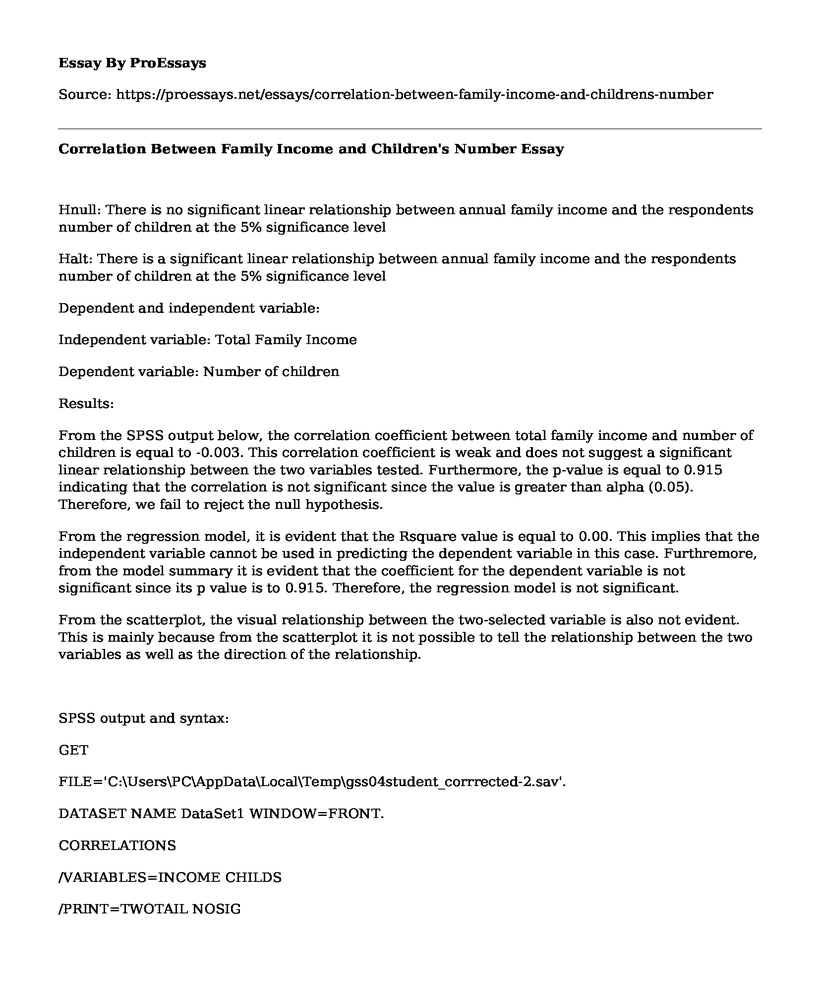Hnull: There is no significant linear relationship between annual family income and the respondents number of children at the 5% significance level
Halt: There is a significant linear relationship between annual family income and the respondents number of children at the 5% significance level
Dependent and independent variable:
Independent variable: Total Family Income
Dependent variable: Number of children
Results:
From the SPSS output below, the correlation coefficient between total family income and number of children is equal to -0.003. This correlation coefficient is weak and does not suggest a significant linear relationship between the two variables tested. Furthermore, the p-value is equal to 0.915 indicating that the correlation is not significant since the value is greater than alpha (0.05). Therefore, we fail to reject the null hypothesis.
From the regression model, it is evident that the Rsquare value is equal to 0.00. This implies that the independent variable cannot be used in predicting the dependent variable in this case. Furthremore, from the model summary it is evident that the coefficient for the dependent variable is not significant since its p value is to 0.915. Therefore, the regression model is not significant.
From the scatterplot, the visual relationship between the two-selected variable is also not evident. This is mainly because from the scatterplot it is not possible to tell the relationship between the two variables as well as the direction of the relationship.
SPSS output and syntax:
GET
FILE='C:\Users\PC\AppData\Local\Temp\gss04student_corrrected-2.sav'.
DATASET NAME DataSet1 WINDOW=FRONT.
CORRELATIONS
/VARIABLES=INCOME CHILDS
/PRINT=TWOTAIL NOSIG
/MISSING=PAIRWISE.
Correlations
Notes
Output Created 21-JAN-2016 08:44:02
Comments Input Data C:\Users\PC\AppData\Local\Temp\gss04student_corrrected-2.sav
Active Dataset DataSet1
Filter <none>
Weight <none>
Split File <none>
N of Rows in Working Data File 1500
Missing Value Handling Definition of Missing User-defined missing values are treated as missing.
Cases Used Statistics for each pair of variables are based on all the cases with valid data for that pair.
Syntax CORRELATIONS
/VARIABLES=INCOME CHILDS
/PRINT=TWOTAIL NOSIG
/MISSING=PAIRWISE.
Resources Processor Time 00:00:00.00
Elapsed Time 00:00:00.03
[DataSet1] C:\Users\PC\AppData\Local\Temp\gss04student_corrrected-2.sav
Correlations
TOTAL FAMILY INCOME NUMBER OF CHILDREN
TOTAL FAMILY INCOME Pearson Correlation 1 -.003
Sig. (2-tailed) .915
N 1341 1339
NUMBER OF CHILDREN Pearson Correlation -.003 1
Sig. (2-tailed) .915 N 1339 1498
REGRESSION
/MISSING LISTWISE
/STATISTICS COEFF OUTS R ANOVA
/CRITERIA=PIN(.05) POUT(.10)
/NOORIGIN
/DEPENDENT CHILDS
/METHOD=ENTER INCOME.
Regression
Notes
Output Created 21-JAN-2016 08:45:37
Comments Input Data C:\Users\PC\AppData\Local\Temp\gss04student_corrrected-2.sav
Active Dataset DataSet1
Filter <none>
Weight <none>
Split File <none>
N of Rows in Working Data File 1500
Missing Value Handling Definition of Missing User-defined missing values are treated as missing.
Cases Used Statistics are based on cases with no missing values for any variable used.
Syntax REGRESSION
/MISSING LISTWISE
/STATISTICS COEFF OUTS R ANOVA
/CRITERIA=PIN(.05) POUT(.10)
/NOORIGIN
/DEPENDENT CHILDS
/METHOD=ENTER INCOME.
Resources Processor Time 00:00:00.02
Elapsed Time 00:00:00.04
Memory Required 2020 bytes
Additional Memory Required for Residual Plots 0 bytes
[DataSet1] C:\Users\PC\AppData\Local\Temp\gss04student_corrrected-2.sav
Variables Entered/Removeda
Model Variables Entered Variables Removed Method
1 TOTAL FAMILY INCOMEb . Enter
a. Dependent Variable: NUMBER OF CHILDREN
b. All requested variables entered.
Model Summary
Model R R Square Adjusted R Square Std. Error of the Estimate
1 .003a .000 -.001 1.661
a. Predictors: (Constant), TOTAL FAMILY INCOME
ANOVAa
Model Sum of Squares df Mean Square F Sig.
1 Regression .031 1 .031 .011 .915b
Residual 3690.132 1337 2.760 Total 3690.163 1338 a. Dependent Variable: NUMBER OF CHILDREN
b. Predictors: (Constant), TOTAL FAMILY INCOME
Coefficientsa
Model Unstandardized Coefficients Standardized Coefficients t Sig.
B Std. Error Beta 1 (Constant) 1.883 .215 8.748 .000
TOTAL FAMILY INCOME -.002 .019 -.003 -.106 .915
a. Dependent Variable: NUMBER OF CHILDREN
GRAPH
/SCATTERPLOT(BIVAR)=INCOME WITH CHILDS
/MISSING=LISTWISE.
Graph
Notes
Output Created 21-JAN-2016 08:46:44
Comments Input Data C:\Users\PC\AppData\Local\Temp\gss04student_corrrected-2.sav
Active Dataset DataSet1
Filter <none>
Weight <none>
Split File <none>
N of Rows in Working Data File 1500
Syntax GRAPH
/SCATTERPLOT(BIVAR)=INCOME WITH CHILDS
/MISSING=LISTWISE.
Resources Processor Time 00:00:02.28
Elapsed Time 00:00:01.90
[DataSet1] C:\Users\PC\AppData\Local\Temp\gss04student_corrrected-2.sav
Cite this page
Correlation Between Family Income and Children's Number. (2021, Mar 03). Retrieved from https://proessays.net/essays/correlation-between-family-income-and-childrens-number
If you are the original author of this essay and no longer wish to have it published on the ProEssays website, please click below to request its removal:
- The Power of Story - Social Media in My Life
- Why Animals Should Be Excluded From Circuses Essay Example
- Combatting Violent Behavior in Kids: AACAP's Comprehensive Guide - Essay Sample
- Terrorism's Impact on Nigeria: Boko Haram's Reign of Terror - Essay Sample
- Paper Example on Gender Inequality in Susan Glaspell's Play: Mrs. Peters & Mrs. Hale
- Paper Example in Planning an Event: Financial & Procurement Tasks
- Making Decisions with Data: Understanding Hypothesis Testing & Statistical Significance - Article Review Example







